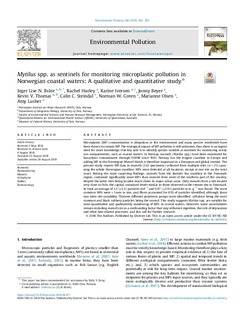| dc.contributor.author | Bråte, Inger Lise Nerland | |
| dc.contributor.author | Hurley, Rachel | |
| dc.contributor.author | Iversen, Karine | |
| dc.contributor.author | Beyer, Jonny | |
| dc.contributor.author | Thomas, Kevin V | |
| dc.contributor.author | Steindal, Calin Constantin | |
| dc.contributor.author | Green, Norman Whitaker | |
| dc.contributor.author | Olsen, Marianne | |
| dc.contributor.author | Lusher, Amy | |
| dc.date.accessioned | 2018-10-31T13:53:47Z | |
| dc.date.available | 2018-10-31T13:53:47Z | |
| dc.date.created | 2018-09-27T10:32:29Z | |
| dc.date.issued | 2018 | |
| dc.identifier.citation | Environmental Pollution. 2018, 243, 383-393. | nb_NO |
| dc.identifier.issn | 0269-7491 | |
| dc.identifier.uri | http://hdl.handle.net/11250/2570429 | |
| dc.description.abstract | Microplastic (MP) contamination is ubiquitous in the environment and many species worldwide have been shown to contain MP. The ecological impact of MP pollution is still unknown, thus there is an urgent need for more knowledge. One key task is to identify species suitable as sentinels for monitoring in key eco-compartments, such as coastal waters. In Norway, mussels (Mytilus spp.) have been monitored for hazardous contaminants through OSPAR since 1981. Norway has the longest coastline in Europe and adding MP to the Norwegian Mussel Watch is therefore important in a European and global context. The present study reports MP data in mussels (332 specimens) collected from multiple sites (n = 15) spanning the whole Norwegian coastline. MPs were detected at all locations, except at one site on the west coast. Among the most surprising findings, mussels from the Barents Sea coastline in the Finnmark region, contained significantly more MPs than mussels from most of the southern part of the country, despite the latter sites being located much closer to major urban areas. Only mussels from a site located very close to Oslo, the capital, contained levels similar to those observed in the remote site in Finnmark. In total an average of 1.5 (±2.3) particles ind−1 and 0.97 (±2.61) particles w.w. g−1 was found. The most common MPs were <1 mm in size, and fibres accounted for 83% of particles identified, although there was inter-site variability. Thirteen different polymeric groups were identified; cellulosic being the most common and black rubbery particles being the second. This study suggests Mytilus spp. are suitable for semi-quantitative and qualitatively monitoring of MPs in coastal waters. However, some uncertainties remain including mussel size as a confounding factor that may influence ingestion, the role of depuration and other fate related processes, and this call for further research. | nb_NO |
| dc.language.iso | eng | nb_NO |
| dc.publisher | Elsevier | nb_NO |
| dc.rights | Attribution-NonCommercial-NoDerivatives 4.0 Internasjonal | * |
| dc.rights.uri | http://creativecommons.org/licenses/by-nc-nd/4.0/deed.no | * |
| dc.title | Mytilus spp. as sentinels for monitoring microplastic pollution in Norwegian coastal waters: A qualitative and quantitative study. | nb_NO |
| dc.title.alternative | Mytilus spp. as sentinels for monitoring microplastic pollution in Norwegian coastal waters: A qualitative and quantitative study. | nb_NO |
| dc.type | Journal article | nb_NO |
| dc.type | Peer reviewed | nb_NO |
| dc.description.version | publishedVersion | nb_NO |
| dc.rights.holder | © 2018 The Authors | nb_NO |
| dc.source.pagenumber | 383-393 | nb_NO |
| dc.source.volume | 243 | nb_NO |
| dc.source.journal | Environmental Pollution | nb_NO |
| dc.identifier.doi | 10.1016/j.envpol.2018.08.077 | |
| dc.identifier.cristin | 1614544 | |
| dc.relation.project | Norges forskningsråd: 257434 | nb_NO |
| dc.relation.project | Norges forskningsråd: 225203 | nb_NO |
| cristin.unitcode | 7464,20,13,0 | |
| cristin.unitcode | 7464,30,21,0 | |
| cristin.unitcode | 7464,0,0,0 | |
| cristin.unitcode | 7464,20,12,0 | |
| cristin.unitcode | 7464,20,19,0 | |
| cristin.unitname | Økotoksikologi | |
| cristin.unitname | Miljøkjemi | |
| cristin.unitname | Norsk institutt for vannforskning | |
| cristin.unitname | Marin forurensning | |
| cristin.unitname | Miljøgifter | |
| cristin.ispublished | true | |
| cristin.fulltext | original | |
| cristin.qualitycode | 1 | |

